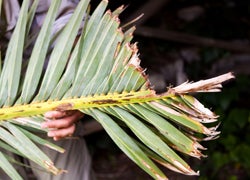
On May 25 2011, a Canary Islands palm suspected of being infested with red palm weevil in a private residence in Laguna beach was inspected for this pest and later treated with insecticides.
The process for selecting and treating palms at Laguna Beach has followed a strict process: (1) Palms with suspected red palm weevil damage (figure “7” notches and straight edges on the tips of fronds, or the presence of pupal cocoons lying on the ground underneath palms) were identified from visual surveys conducted on the ground. These palms were recommended for secondary inspection. (2) Detailed secondary visual inspection of suspect palms required the cutting of an observation window to access the central growing area of the palm to look for red palm weevil feeding damage. This is a highly favored feeding and breeding site. During frond removal to create the observation window, cut palm fronds were examimed for weevil feeding damage, the presence of pupation chambers and cocoons, and live and dead life stages, especially pupae and adults. (3) Confirmation of red palm weevil infestation (e.g., the presence of pupal cocoons in the tree, feeding tunnels made by larvae, or body parts of dead adults) based on the detailed secondary inspection triggered pesticide applications to control the pest population in the palm. This three step evaluation process culminating with the ultimate decision to treat with insecticides involved representatives from the Orange County Agricultural Commissioner’s Office, CDFA, USDA and local (UC Riverside), national (University of Florida), and international University (Spain and Israel) experts.
Dr. John Kabashima (University of California Cooperative Extension) organized this project and participants included Dr. Mark Hoddle (University of California, Riverside) Gilbert Vargas (Vargas Tree Services and Landscaping, Anaheim [palm climbing and inspection personnel]), Kevin Holman (RPW Pest Control Services [pesticide applications]), Nick Nisson (Orange County Entomologist), Laura Petro (CDFA), palm specialist Dr. Henry Donselman, and representatives from the date palm industry (Albert Keck [Hadley Dates] and Duane Young [Cocopah Nurseries]).

The tree selected for inspection and treatment had obvious feeding damage to palm fronds consistent with red palm weevil. This damage included fronds with straight ends instead of pointed ends, figure “7” notches, and oval windows in leaflets.
Secondary inspection of the tree required an experienced arborist to climb into the crown of the tree using ropes and a harness.
Once at the crown, an observation window was cut. This involved the removal of approximately two outer layers of mature palm fronds in a 6-7 foot lateral span to allow visual and physical access to the apical growing region in the center of the crown. This region of the palm tree is most sensitive to red palm weevil feeding damage and it is a highly preferred feeding site.

As fronds were cut for the observation window, they were dropped to the ground and these fronds were inspected for live red palm weevils and damage. Several (around 5-6 of about 10-12 cut fronds) showed feeding damage by red palm weevil and empty pupal cocoons were also found in pupation chambers at the base of some fronds. The ages of these cut palm fronds were estimated at 3-4 years by Dr. Donselman. Younger fronds showed no evidence of damage by red palm weevil. Two dead adult red palm weevil adults were found. Both adults were black with the red stripe. This is the same color morph found previously in Laguna Beach.
NO LIVE RED PALM WEEVIL ADULTS, PUPAE, OR LARVAE WERE FOUND DURING INSPECTIONS.

After inspection, cut palm fronds were destroyed by chipping before being transported to a local landfill to be buried.
The inspected palm tree was subjected to three different insecticide treatments:
(1) the inspection window, crown and trunk were sprayed with bifenthrin, a synthetic pyrethroid that acts as a direct contact and residual insecticide. This means any red palm weevil either sprayed directly or that would later come into contact with dried residues on the exterior surfaces of the palm could be killed.
(2) The soil was pressure injected with imidacloprid, a neonicotinoid insecticide. This compound is systemic and will move slowly from the soil in water that is drawn up by the palm tree. Adult or larval red palm weevil feeding inside palm protected from exterior sprays may killed by imidacloprid moving internally up the palm tree to the crown, the area where red palm weevils are suspected to be feeding.
(3) The final insecticide application was dinotefuran, another neonicotinoid insecticide that has rapid systemic activity. This product was applied to the trunk of the palm tree from soil level to a height of approximately two meters above the ground. This insecticide moves inside the palm tree after it passes from the exterior of the trunk into nutrient conducting tissues where it will be translocated to the crown of the palm. Valent (dinotefuran) and Bayer (imidacloprid) donated the systemic insecticides used in these treatments against red palm weevil, and Target Specialty Product donated the bifenthrin.

The CDFA took samples from cut palm fronds to test for insecticide residues that may have been present in the palm prior to treatments. The CDFA will monitor insecticide uptake by the palm by periodically taking leaf samples and checking for the presence of imidacloprid and dinotefuran. These analyses will provide information on how quickly the systemic insecticides move to the crown of the palm tree and whether concentrations reaching the crown are high enough to kill red palm weevil larvae and adults.
Organized by John Kabashima (UCCE)
Palm Tree trimming services provided by Vargas Tree Services and Landscaping
Pesticide application provided by RPW Pest Control Services
Pesticides donated by Bayer, Valent, and Target Specialty Products
Want more? Go to the CISR website for more on Red Palm Weevil